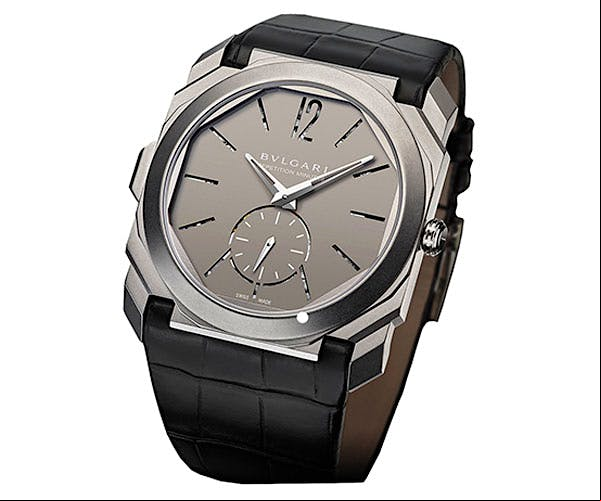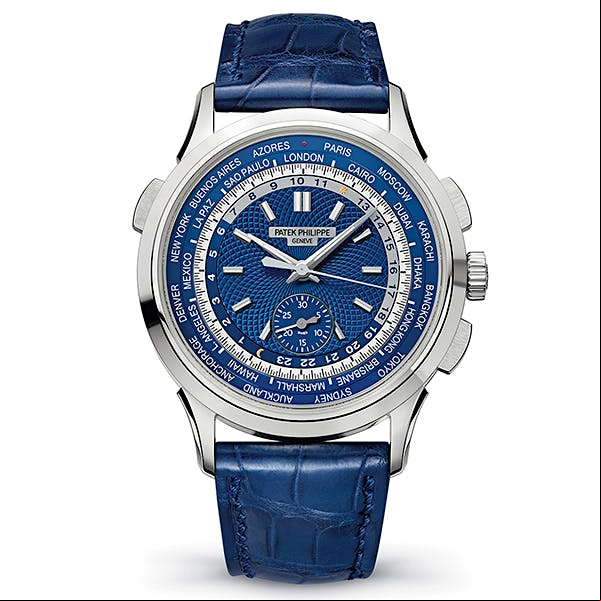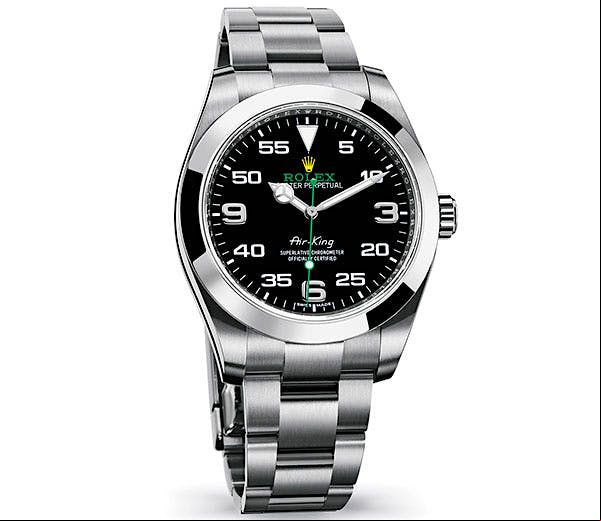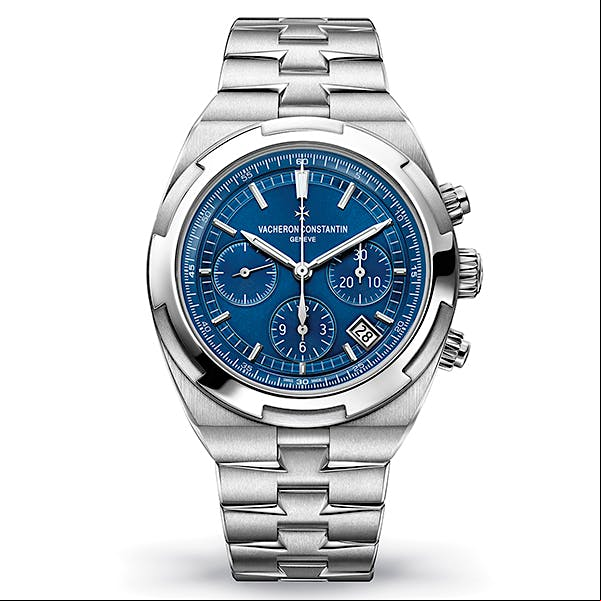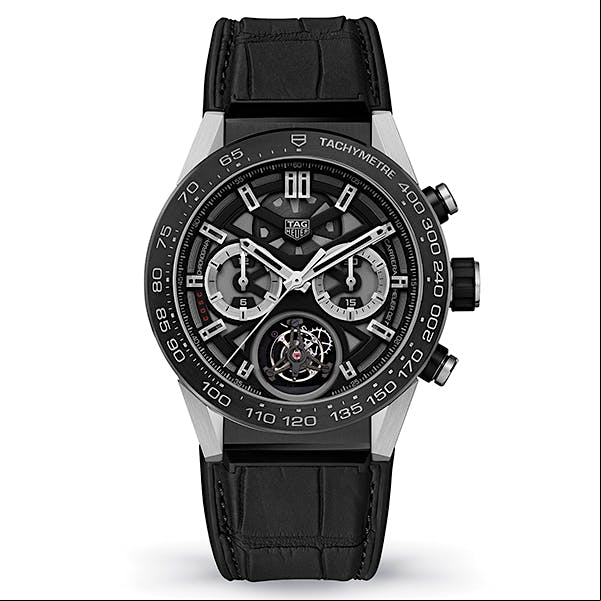The Head Turners In Time

The outlook at this year's Swiss watch fairs was decidedly gloomy. Even before summer's historic Brexit decision that threw markets into turmoil, global economic conditions had cast a pall upon the overstocked luxury watch market. Accordingly, the tendency was to retreat to the safe havens of classic design and revamped tried-and-true models. The watches that stood out, however, were the few which still dared to break records, flout convention and part from the crowd.
Greubel Forsey Signature 1
Best known for its audacious and highly technical tourbillons at stratospheric prices, Greubel Forsey surprised us this year with a three-hand watch that expresses the purity of timekeeping while showcasing the brand's superlative quality and finishing.
The Signature collection will evolve with timepieces envisioned by a single watchmaker seeking to express the Greubel Forsey philosophy, while drawing upon the significantly skilled resources of the atelier. Signature 1 is the brainchild of Didier Cretin, an accomplished Greubel Forsey team member, who co-signs each Signature 1 with Stephen Forsey and Robert Greubel. They will produce 11 pieces each in platinum, white gold, and rose gold, plus an "entry level" Greubel Forsey limited to 33 pieces in stainless steel (150,000 Swiss francs, or about $153,000).
The off-center dial may be reminiscent of the brand's GMT, but Signature 1 projects a much more classical tone, despite the lower section of the dial being left open to show off the traditional balance wheel and interior architecture of the movement. As it is the first Greubel Forsey without a tourbillon regulator, the piece is by far the least expensive in the collection. Still it is among the world's most expensive three-hand watches ... and one that is sure to sell out. greubelforsey.com
Bulgari Octo Finissimo Minute Repeater
Bulgari broke a record with the world's thinnest minute repeater, the Octo Finissimo Minute Repeater ($155,000), which marks the pinnacle of the Finissimo collection of ultrathin watches. Bulgari's engineers set out to build a minute repeater for the modern age, rather than one that celebrates tradition. The minute repeater is a complication that predates electricity. It chimes the hours, quarter hours and minutes on a series of tiny wire gongs that are struck with miniature hammers on demand.
As musical watches usually rely on case volume for sound resonance, building an ultrathin minute repeater is unprecedented. Instead, Bulgari cut away the indexes on the dial to allow the sound to transmit through the dial. Titanium was also selected for the case and dial material because its properties make it superior for sound propagation, while steel was used for the gongs for the same reason. Another goal was to create a minute repeater for everyday wear rather than one that would sit in a vault most of the time. Measuring a mere 6.85 mm, the svelte sandblasted titanium case with its cutting-edge angles brings a disruptive contemporary attitude to the historically revered complication. bulgari.com
Audemars Piguet Royal Oak Double Balance Wheel Openworked
Audemars Piguet's Royal Oak Concept Supersonnerie, which hits the market this year, also set a minute repeater record: the world's loudest. But that technology comes at an incredibly steep price-more than a half million dollars. However, Audemars Piguet released another groundbreaking technical achievement in a Royal Oak that flipped the typical script that says watchmakers usually launch significant advancements in their highest-end watches before filtering the technology down through the collection. The 41-mm Royal Oak Double Balance Wheel Openworked ($44,100 in stainless steel) achieves heightened chronometric stability for a 30 percent increase in precision by adding a second balance wheel and balance spring assembly that is fixed on the same axis. The patented movement is showcased with Audemars Piguet's exceptional skeletonization, an art form for which the brand has been celebrated for decades. audemarspiguet.com
Patek Philippe World Time Chronograph Ref. 5930
In the new World Time Chronograph Ref. 5930 ($73,700), which is inspired by a unique piece from 1940, Patek Philippe combined two of its most prized complications: a chronograph and world time function.
The piece s the world-time module, a concept originally developed by Louis Cottier in the 1930s, to the self-winding CH 28-520 PS chronograph caliber with column wheel and a vertical clutch. By making extensive modifications, Patek Philippe has created the new CH 28-520 HU movement.
One may expect the first casualties of such a fusion would be legibility and elegance. But the dial retains the classic layout of Patek world timers with a two-tone, 24-hour ring (to indicate night versus day) paired with the city ring around the periphery of the dial, representing the world's 24 primary time zones. A simple push on the button at 10 o'clock allows you to adjust zones while keeping track of time around the globe. In between these two rings is the seconds scale for the flyback chronograph that pairs with a 30-minute counter in a sub-dial at 6 o'clock to track elapsing time. And because the chronograph hand is powered by a vertical clutch, it can double as a permanently running seconds hand without risking wear and tear or diminishing accuracy and power reserve.
At a streamlined 39.5 mm in diameter and 12 mm thick, Patek Philippe managed to deliver all that functionality in a refined 18-karat white gold package with winglet-style strap lugs, a distinguishing design flourish of its 1940s and 1950s World Time watches. patek.com
A. Lange & Söhne Richard Lange Jumping Seconds
Once again, the German watchmaker dazzled this year with high complications such as the Datograph Perpetual Tourbillon-combining a flyback chronograph, perpetual calendar and tourbillon. But the platinum Richard Lange Jumping Seconds (78,000 euros, or about $86,000) caught our eye for its unconventional spirit. Limited to 100 pieces, the Jumping Seconds is the third Richard Lange model to exhibit a triangular-shaped regulator dial design with three subdials (one for hours, another for minutes and the largest for seconds) paired with a constant force device for enhanced timekeeping. The Jumping Seconds regulates at one-second intervals to make the dominant seconds hand jump rather than sweep around the dial like most mechanical watches. An elegant zero-reset system synchronizes everything when you pull the crown. alange-soehne.com
Rolex Air-King
As watch enthusiasts gushed over the new steel Daytona with a black Cerachrom ceramic bezel, Rolex's retooled Air-King ($6,200) stole some of the leading man's spotlight this year. This upsized 40-mm 904L steel incarnation of the 1950s-era pilot watch swaggers with a black dial marked with a mix of large hour digits and smaller minute digits inspired by '40s-era military cockpit instruments, plus a prominent minute track around the periphery. The dial is also embellished with a yellow crown, the green Rolex logo, plus a vintage Air-King logo in a nod to the model's historical roots. The piece is also labeled as a Superlative Chronometer, attesting to Rolex's stringent testing for high-precision performance. And like the Milgauss, the movement is protected from omnipresent magnetic fields with a soft-iron inner case. rolex.com
Oris Carl Brashear Limited Edition
Oris also went retro with a limited-edition dive watch that pays homage to Carl Brashear, the first African-American to achieve master diver status in the U.S. Navy. Cuba Gooding Jr. famously portrayed Brashear in the 2000 film Men of Honor. Not only did Brashear face intense racial discrimination when he ed the navy in 1948 at the age of 17, he lost the lower part of his left leg in a 1966 accident while trying to salvage a hydrogen bomb. Yet, he continued diving as an amputee.
In a nod to material used for deep-sea diving helmets in the 1950s, Oris cased the 42 mm Carl Brashear Limited Edition ($2,800) in bronze, which develops a distinctive patina as it ages, making each of the 2,000 watches unique. The retro aesthetic with a deep blue dial was borrowed from last year's Divers Sixty-Five. And as you might expect, the watch is water-resistant down to 100 meters. Proceeds from sales will benefit the Carl Brashear Foundation. oris.ch
Vacheron Constantin Overseas Chronograph
Vacheron Constantin also revisited a contemporary classic—its travel-inspired Overseas sport-watch collection with a redesign and five new Geneva Seal models, including the 42.5-mm Overseas Chronograph available in stainless steel ($28,900) or 18-karat rose gold ($49,000) with a choice of gray or blue dials. Last updated in 2004, the Overseas originally launched in the 1970s with three other legendary sport watches that were designed by Gerald Genta that carry on to this day: Audemars Piguet's Royal Oak, Patek Philippe's Nautilus and IWC's Ingenieur SL.
Vacheron spent five years developing the watch's engine, the finely finished automatic Calibre 5200, with 263 components including a column wheel and vertical coupling clutch to ensure smooth action. A sapphire-crystal case back reveals the movement with a 22-karat-gold oscillating weight engraved with a com rose, a historic symbol that helps travelers find their bearings.
The slightly tweaked Overseas case design is a rounded tonneau shape with a round dial surrounded by a bezel sculpted with six notches. The integrated bracelet is easily changed thanks to a new system that requires no tools. The steel model comes with a steel bracelet plus alternate rubber and alligator straps, so you can change the look of your Overseas in an instant. vacheron-constantin.com
Laurent Ferrier Galet Square Boréal
Laurent Ferrier arrived on the Swiss watch scene in 2010 with its signature Galet collection (galet means pebble in French), fusing classical and contemporary aesthetic codes. Over the past six years, the boutique brand has evolved its flagship line into the cushion-shaped Galet Square. This year's upsized (41 mm by 41 mm) Galet Square Boréal ($38,000) infuses this supremely elegant watch with an Art Deco look by appointing it with a simplified sector dial reminiscent of watches from the 1930s. The chapter ring and arrow-shaped hands are treated with Superluminova so they light up in the dark.
Under the chic dial is the first movement the brand developed in-house. The automatic FBN 229.01 calibre is equipped with a unidirectional pawl-fitted micro-rotor that efficiently winds to deliver the watch's three-day power reserve. The movement features a silicon escapement and two escape wheels to produce a double direct impulse on the balance, maximizing energy efficiency and performance. This cutting edge movement is painstakingly finished with the traditional Côtes de Genève motif on the bridges, circular graining on the main plate, and other fine touches—all of which are visible through the sapphire-crystal case back. laurentferrier.ch
TAG Heuer Carrera Heuer-02T Tourbillon
Part of the tourbillon's historic allure is its rarity and exclusivity. Before 21st-century advances in watchmaking technology, simply achieving a tourbillon was a badge of pride. Tourbillons (rotating cages that contain the escapement and balance wheel to counter the effects of gravity) used to be exceedingly uncommon and priced accordingly steep—often $50,000 to $100,000 and up. But TAG Heuer has turned that notion on its head with the industrialized Carrera Heuer-02T. The COSC-certified automatic chronograph is combined with a titanium and carbon flying tourbillon with a power reserve in excess of 65 hours. What really stopped us in our tracks was the price, starting at $15,900 in titanium.
TAG Heuer rethought every step from the way the mechanism is built to the machinery used to the time a watchmaker spends on assembling and adjusting the watch. Jean-Claude Biver, TAG Heuer's CEO, likens the new process to building with Legos, where the elements fit together solidly and seamlessly, so no time-consuming watchmaker adjustments are required. When you minimize the labor hours, the price naturally falls.
The watch traces its aesthetic codes to the Carrera Heuer-01 and its movement to the CH-80 chronograph fitted with a lightweight tourbillon inspired by the Monaco V4's tourbillon.
Of course you cannot expect a $16,000 tourbillon to have the fine finish and other hallmarks of extreme quality of watches costing many times more, but this edgy tourbillon makes the revered complication accessible to a wider audience and a younger generation of collectors who ire the mesmerizing spinning wheel but never dreamed of actually wearing one. tagheuer.com
Laurie Kahle writes frequently for Cigar Aficionado on watches and travel.
